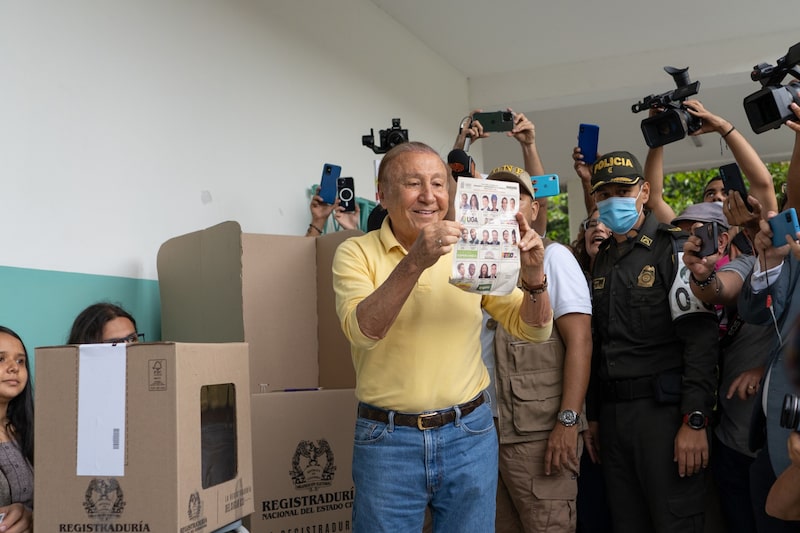Bloomberg — The social media campaign that propelled a 77-year-old construction magnate into Colombia’s presidential runoff deliberately cultivated his image as an anti-politician to tap voter anger against the political class, according to the strategist who helped devise it.
Rodolfo Hernández, who is now refusing to take part in debates and has shunned election rallies, used popular social media posts to overcome a series of controversies and at least one potentially career-destroying gaffe, said Víctor López, founder of Kayros Group, a political strategy firm that worked on the campaign.
“His message has been clear: he’s not a traditional politician and has always presented himself as the anti-politician, an outsider, independent of Colombia’s traditional political class,” López said in a video interview from Madrid. “His top three weapons when we studied his campaign were his authenticity, his humor and his charisma, so we worked with that.”
The first round catapulted Hernández from little-known onetime mayor of a provincial city into the favorite for the June 19 runoff. He turned the tables on presidential rival Gustavo Petro, 62, a senator and former mayor of Bogota who had been tipped to become Colombia’s first leftist leader.
‘Biggest Mistake’
López, 37, has worked with candidates throughout Latin America including El Salvador’s President Nayib Bukele, and said that he had to rebrand Hernández’s struggling campaign last year and design a strategy to boost his name recognition. His team had to fend off scandals such as Hernández slapping a local politician and his comments calling Adolf Hitler a great German thinker -- “the biggest mistake I’ve seen in a political career,” López said.
Kayros Group worked on the campaign from October through late January before leaving over what López said was “incompatibility.”
At that time, they focused on social media after finding that more than 80% of Colombia’s 51 million people could be reached online, and created a video of Hernández wearing sunglasses while sitting backward in a chair. The clip opens with the phrase “viejo pero sabroso,” which translates roughly as “old but tasty,” trying to make Hernández appear informal and fun. It has 1.7 million views.
No Stealing
Some 36 million Colombians can be reached through Facebook with another 30 million via YouTube, while the reach for Instagram and TikTok is 18 million and 14 million respectively, López said. Twitter lags by comparison with about 4 million, he said.
The campaign highlighted public works projects Hernández built during his time as mayor of Bucaramanga in northeastern Colombia and adopted slogans such as “there’s enough money when no one steals,” a popular refrain of Bukele’s during his 2019 ascent to power.
Voter support for Hernández rose from 5% to 15% in the three months they worked together, López said. In the May 29 first round, he took more than 28% of the vote.
“We decided to throw out the script,” said López. “He just had to be authentic without making serious mistakes.”
Youth vote
Markets rallied in the expectation that Hernández can spoil Petro’s bid to overhaul Colombia’s economic model. The Colombian peso (USDCOP) is the second-best performing currency this week.
Yet Hernández’s economic program remains largely a blank slate, while his anti-corruption focus is tarnished by the fact that he’s being investigated for potential irregularities in tendering public contracts while mayor.
Polls still suggest a close race, and for all Hernández’s use of TikTok, a breakdown of voting intention shows Petro enjoys far greater support among the 18-40 age group.
Hernández is still projecting authenticity. He spent election day by the pool at his country home near Bucaramanga, while his speech after the results came in showed him sitting in the kitchen while supporters rallied in a public square in the city.
Petro, who has criticized Hernández by saying that graft can’t be stomped out with TikTok videos, seems to be taking note: He’s no longer holding campaign rallies across the country.
Incumbents ‘destroyed’
The unpredictable race in Colombia comes on the back of a series of defeats for ruling parties across the region, as inequalities that were exposed by the pandemic and deepened by inflation shake up politics.
Within the last year, voters in Peru and Chile elected unconventional presidents, while Honduras voted in Xiomara Castro following 12 years of conservative rule. But it’s not simply a “pink” wave: Costa Rica elected conservative Rodrigo Chaves to end eight years of leftist PAC party rule.
“You see the same pattern in every election,” López said. “Ever since Covid-19 started, ruling parties are getting destroyed.”
In Colombia, Hernández has attracted endorsements from defeated candidates, potentially tipping the balance in his favor. López said he expects Hernández to stick with the campaign strategies that helped him get this far. If anything, the social media blitz has only intensified under his new strategists.
“The reality is that citizens were asking for change throughout the country,” López said. “What we did was listen to Colombians.”




